Black Friday is fast approaching and the holiday shopping craze is already underway. This year, it will occur on November 25, and with the clock ticking, it’s vital to have a strategy in place so you can be part of the action.
We all know that Black Friday is a day when retailers make the biggest profits of the year, but while Black Friday can be an opportunity to make money, it’s also a chance to boost your brand and gain recognition among new audiences — especially if you market yourself well.
Based on past years’ data, it’s estimated that about 190 million U.S. shoppers will make a purchase over the weekend covering Black Friday — from Thanksgiving day to Cyber Monday. On average, each person will splurge north of $300.
So how can your organization reach these shoppers and even those that don’t intend to spend? And if you’re a B2B brand, how can you capitalize on a bonanza that is so clearly B2C?
Let’s explore 10 successful ways to elevate your marketing this Black Friday.
Examples of Black Friday Marketing Ideas in Action
The digital era and the rise of e-commerce have made it possible to build anticipation in an entirely new way — through social media and online campaigns, as well as traditional advertising. An event that was once purely an in-person rampage to the doors of your favorite big box store migrates more each year to steep online sales completed from the comfort of your couch. This year, it’s expected that 130 million U.S. shoppers will head to the internet for Black Friday deals, which will generate an estimated $22 billion in sales.
And with that reality in mind, there’s no reason why Black Friday has to be just Friday. Brands reaching customers online are free to do so any day of the week, subsequently leading to the explosion of Cyber Monday. The lines between these two days are blurring — and to great effect for savvy marketers.
Keep your sales numbers high this holiday season with these marketing strategy tips:
1. Get in Early
Online queries of “black friday” peak the week of Thanksgiving, which makes sense. But they begin to trend noticeably upward around Oct. 13 or so.

This means Black Friday marketing campaigns should start at least a month before the big day, and to be fully prepared for the Black Friday rush, the strategy, planning and testing for these campaigns would need to have occurred earlier in Q3 — giving you enough time build up your brand presence in search engines and social media, as well as create an email list for future promotions.
Starting early with content creation, audience research and social media promotions will help you get a jump on your competition — and as potential customers start searching for their Black Friday deals, you can be one of the first brands that pop up.
E-commerce platform Shopify began posting Black Friday content on Instagram a month before the holiday weekend.
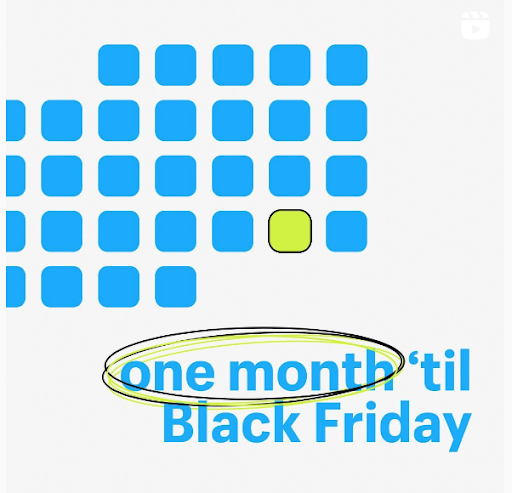
The company continued to post successive messages on social media when Black Friday awareness really starts to pick up in the marketplace.
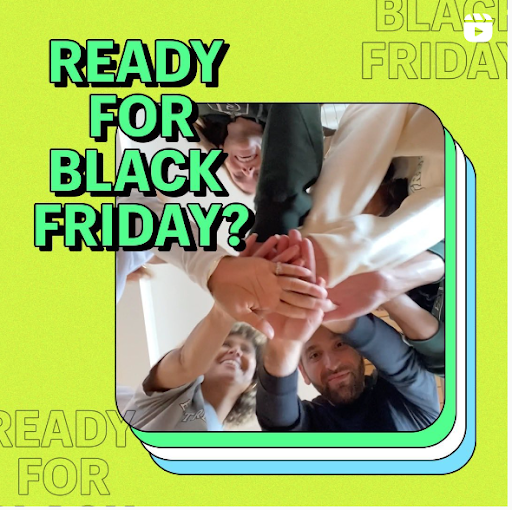
However, their online marketing efforts began much earlier in September with a series of blog posts that shared tips and best practices for merchants. Shopify also created an interactive, animated video that explained their service and how to use it for Black Friday promotions.
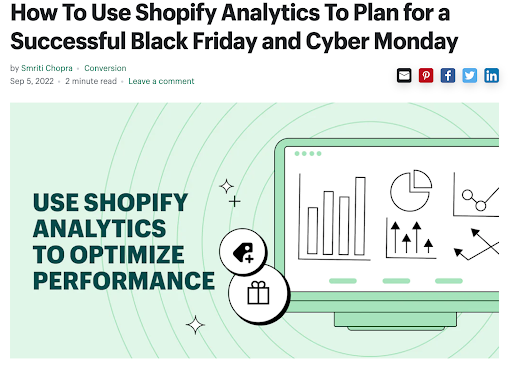
The sooner you launch a promotion, gift card or discount code — and the more frequently you update it with fresh content — the better your data will be over time. Using this information, you’ll be able to perfect your targeting and messaging across various touch points throughout the month.
2. Make Your Black Friday Last Longer
As mentioned above, there’s no rule that dictates your Black Friday deal can’t segue into a Cyber Monday deal — or even beyond.
Due to the nature of consumer behavior, some people are purchasing goods for themselves while others are buying gifts for others. In the latter case, a large portion of Black Friday merchandise won’t actually be gifted until Christmas.
Post-Christmas is also the time when consumers return unused or unwanted products. And it’s when they actually spend the gift cards they received. Your brand can capitalize on this timing by offering additional discounts, upsell opportunities and trade-in value well into January.
Considering the challenges the global supply chain faces this year in particular, it’s possible gifts and gift returns will stretch into February, even. So your original Black Friday marketing strategy is really a multi-quarter investment that might not pay off until next year.
With this in mind, you might be able to trim down your timed Black Friday ad spend post-November, but don’t switch off your marketing entirely. Today’s Black Friday prospects could be February’s hot leads. Accordingly, think of Black Friday as a marketing continuum, not a flash sale.
Think of Black Friday as a marketing continuum, not a flash sale.
3. Make Every Day of the Month Black Friday
In addition to expanding the length of time in which you run your Black Friday promotion, you can also maximize each day of November. Make your own rules — especially if you’re in a crowded space and competing with other brands.
Beauty brands like Sephora and Ulta have made great use of conforming their marketing to “25 Days of Christmas” deals in which customers can unlock new products each day leading up to Christmas. Anthropologie also releases its own “24 Days of Beauty” Advent Calendar.
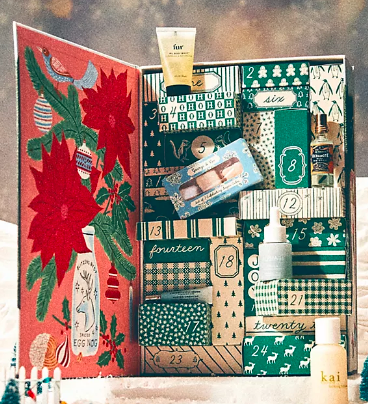
The same principle applies to Black Friday. Deliver a new discount or promote a new product each day of the month, rather than incentivizing all customers toward the same product during a small window of time.
Daily product-reveal teasers can help keep your campaign fresh and exciting by building anticipation among your audience.
4. Deliver a Mobile-First Experience
More than 60% of Google searches originate on mobile. Not to mention the mobile version of your site is considered by Google to be the “true,” primary domain it ranks in search.
Needless to say, shoppers’ mobile experience must be a top priority for Black Friday marketing. This extends to branded apps and other mobile apps consumers use to discover, research and compare products, like YouTube, BuzzFeed and Amazon.
For your mobile site specifically:
- Use pop-ups in good measure. While pop-ups and other interstitials are integral to attracting buyers, on a mobile device, they can severely impede user experience.
- Optimize for page speed. Slow-loading pages can cause users to bounce and cost you valuable sales. Use Google’s free tool.
- Compress imagery and on-page elements. Google’s E-A-T guidelines define how to increase loading times by ensuring blocks of content don’t render too slowly.
- Remove disruptive banners or unnecessary code. Some websites are fundamentally not architected for mobile, and even a responsive web design won’t suffice for a truly mobile-first experience. Large visual impediments and clunky code should be optimized or avoided.
- Use Accelerated Mobile Pages (AMP). AMP is Google’s mechanism for creating mobile-friendly pages via a plugin. This easy-to-use tool will automatically remove some of the code, formatting and media files that desktop sites commonly use.
Subscribe to
The Content Marketer
Get weekly insights, advice and opinions about all things digital marketing.
Thank you for subscribing to The Content Marketer!
5. Overcome the ‘Messy Middle’
While common wisdom states that it takes about 8 touchpoints for a lead to become a customer, that’s merely an average in industries for which data is available. In some cases, it can take dozens of touchpoints and months of research before a consumer is prompted to take decisive action. Or in an instance Google uncovered in 2019, it took more than 250 touchpoints over 73 days for a person to buy a pair of jeans.
This is the reality of a non-linear customer journey where consumers process a lot of information halfway through the funnel before coming out on the other side with a decision. Referred to as the “messy middle” by Google, shoppers are gathering information across multiple devices and websites, as well as from friends and family.
What transpires in this “messy middle” can sometimes be a marketing black box. Funnels are never the fastest route from point A to point B, as much as marketers wish they were.
The customer journey is more like a constellation or a web, with various stops and starts. It’s imperative that brands maintain their presence and consistency across the entire Black Friday shopping “season.”
If your brand pulls the cord too early on its campaigns, you may inadvertently be leaving behind potential customers who haven’t made it past the messy middle. At this stage, shoppers need reassurance and urgency, which can be found in the form of:
- Social proof. Positive user reviews are some of the most impactful motivators behind decision-making.
- Category heuristics. Short, persuasive descriptions simplify communications and make decision-making less of a hassle.
- Scarcity bias. As inventory runs out, shoppers know they need to act soon.
- Authority bias. The use of organic and paid influencers can add authority and expertise to your marketing.
- Power of now. If you can guarantee quick shipment and delivery, your product is more enticing.
- Power of free. Everyone loves free.

6. Go Big on Guides
Decades ago, big retailers like Sears and JCPenney mailed thick catalogs of carefully curated and professionally photographed merchandise.
Modern holiday shoppers get the same idea from epic online guides that take some of the guesswork and comparison shopping out of the buying equation.
BuzzFeed has a dedicated landing page devoted to an evolving rotation of gift guides that feature unusual and niche products for a wide variety of audiences — and they earn affiliate commissions from products sold.
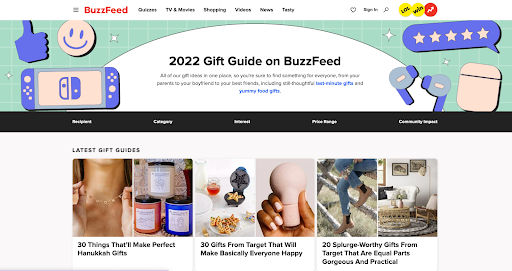
Top publications like the New York Times and Consumer Reports do the same, albeit with a bit more restraint. There are about 1.4 billion search results for “black friday guide,” so the appetite for curated content is enormous.

Going one step further, creating a gift guide based on user inputs can allow Black Friday shoppers to do more than just browse from a catchall catalog of offerings. For example, The Everygirl, an online blog, lets site visitors effectively choose their own persona from a pre-selected list of options — including “Person who has it all” and “Future CEO.” They are then directed to a more personalized gift guide that moves them along in the funnel.
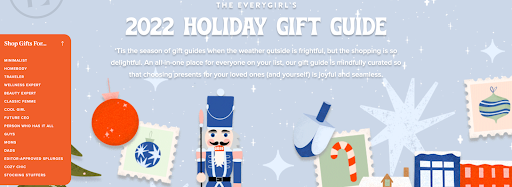
For retailers with large, diverse inventories, a custom gift guide can drive greater engagement at a moment when sales competition is highest.
7. Promote Brand Uniformity Across All Channels
A coordinated effort across all marketing and sales channels allows you to collect data from millions of touchpoint permutations. Email, e-commerce, social media, in-person, SMS, app — customers need all versions of a storefront to find and purchase from you.
Holiday shopping is never completed in one fell swoop. It can take months of planning and lots of periodic purchases. When customers are ready to buy, their preferred channel should be available and their discounts easily accessible. A code received via email should be easy to enter into a mobile form fill, for instance. Or a QR code in your store that promises online rewards needs to function as designed. It is easy to create these codes using one of these best QR code generators.
One crack in your marketing and sales process can increase churn and shopping cart abandonment — if customers even make it as far as a shopping cart.
Because traffic sources are so diverse, and shoppers switch between them throughout the funnel, your messaging and user experience requires cohesion.
8. Invest in Sponsored Influencers
Though we don’t typically recommend black hat techniques or paid tactics when organic marketing can do the job more effectively and inexpensively, new social media platforms have made a strong case for sponsored influencer marketing.
Brands like Mucinex, Kroger and Chipotle have used TikTok to amazing effect, with the burrito retailer in particular seeing a 99% increase in digital sales over the course of several influencer marketing campaigns. Because the vast majority of its audience is Gen Z or millennials, Chipotle recognized the validity of working in new mediums.
However, 2022 has seen a rise in micro-influencers who have strong niche audiences and a high engagement rate. These influencers often come with a more authentic voice and approach to their audience than their larger counterparts, which today’s consumers are craving.
Short-form video promotions that coincide with events like Black Friday have the potential to increase brand reach and urgency bias for maximum impact. Social media campaigns should also leverage Black Friday hashtags across all relevant platforms.
9. Consider Freebies, Bundles or Sideline Offerings
During the final stages of price-shopping, search queries for “rebates” and “coupons” rise sharply. But if you’re not able to price your products or services even lower as holiday deadlines loom, you can opt instead for free giveaways or value bundles.
E-commerce and brick-and-mortar retailers alike can bundle some of their least- and most-prized merchandise, which moves old inventory off the shelves and can provide better margins than on single-item purchases.
Or, you can promise a free trial of your service for a period of time.
Pricey B2B services often come with long contracts, and competitive pricing strategies are off the table. BuzzSumo suggests “sideline offerings” as incentives instead, such as strategy sessions or hands-on expert consultations.
10. Embrace Interactive Content
Interactive content is one of the most engaging and innovative ways to stand out from the competition. During high-volume shopping seasons, brands capitalize on interactivity by promoting:
- “Spin to win” wheels. These features allow website visitors to spin a wheel to unlock freebies, steep discounts and product bundles that aren’t otherwise accessible.
- Online quizzes. These can be used to educate shoppers about a product or service, but they’re also effective at driving action. For example, a cosmetics brand might ask consumers to complete an online quiz that assesses their skin type before offering them personalized recommendations for beauty products and treatments.
- Scavenger hunts. In 2021 H&M, hosted hidden discount codes on their sites to prompt additional user navigation. By navigating to and accessing deeper pages of the website, users can discover special sales that average customers can’t find. The more committed a buyer is to a brand, the better chance they have of finding a reward at the end of their scavenger hunt.
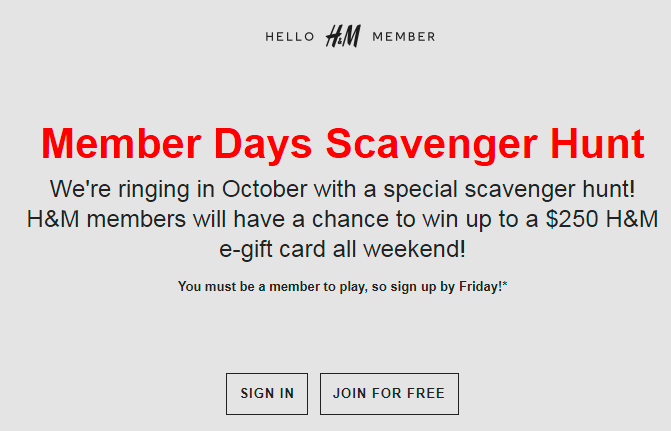
Late to Black Friday? Pivot to a Cyber Monday Sale
All is fair in marketing. With the majority of sales occurring online, there might not be much distinction between Black Friday and Cyber Monday — and that’s likely a good thing.
Both encourage the same type of customer behavior (splurging), and promotions for one are essentially synonymous with the other.
A key lesson here is that nearly any type of aggressive sale or campaign can be adapted to hit changing deadlines, demographics or business needs. Black Friday offers a unique opportunity to collect and analyze lots of shopper data — whether successful or not — to better understand intent and engagement in the future.
And that’s an enduring, invaluable consequence of Black Friday for today’s brands: the ability to optimize next year’s campaigns for even greater impact.
OK. BRB. I’m missing an urgent sale that won’t come again.
Editor’s Note: Updated November 2022.





